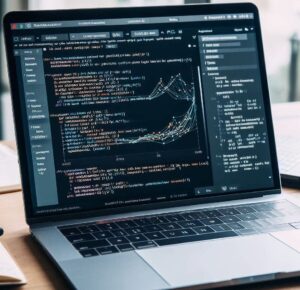Predictive Analytics, a field of analytics that projects future outcomes based on historical data, has turned out to be vital for businesses worldwide. By leveraging machine learning techniques and statistical algorithms, organizations are making foresighted decisions, minimizing risks and optimizing their operations. In the center of this transformative technology, lies TensorFlow, an open-source platform extensively used for machine learning and deep learning applications.
The true power of Predictive Analytics is harnessed when it’s lined up with deep learning capabilities of TensorFlow, a powerful platform built by Google Brain.
Understanding Predictive Analytics

Predictive analytics has radically changed the way businesses analyze and interpret data. Moving beyond the realm of merely descriptive analytics – which focuses on understanding past data to glean what has already occurred – predictive analytics employs machine learning algorithms and statistical techniques to extrapolate future trends and outcomes based on historical data.
This shift from relying on reactive analysis to proactive prediction has significant ramifications. Predictive analytics equips businesses with insights to anticipate future occurrences, enabling well-informed and foresighted decision-making. This has implications on actions ranging from tactical business decisions to building strategic roadmaps, by helping organizations forecast customer behavior, market trends, and operational efficiency.
The reach and relevance of predictive analytics are not limited to any particular sector, with real-world applications witnessing an exponential rise across varied industries. For instance, in the healthcare sector, predictive models enable preventative care by predicting the likelihood of disease incidence at early stages. These models can also help formulate personalized treatment plans based on an individual’s risk factor, significantly improving patient outcomes.
In the e-commerce landscape, predictive analytics powers product recommendation systems, creating personalized shopping experiences. By analyzing a customer’s past purchases, browsing behavior and preferences, predictive models can forecast the products a customer would likely be interested in, thereby improving conversion rates and boosting customer engagement.
Logistics companies are employing predictive analytics for efficient demand forecasting and route optimization. This allows them to anticipate future demand surges, manage inventory effectively, and optimize shipping routes to reduce operational costs and increase efficiency.
Implementing predictive analytics is not without its challenges. The efficacy of a predictive model depends on the quality and relevance of data it is trained on. Aligning the right data and ensuring thorough data cleaning and preprocessing is a prerequisite. In addition, the task of choosing an appropriate predictive model that aligns best with the business problem at hand is equally important and requires expertise. Also, the predictions made by these models need constant validation and refinement to ensure their applicability and reliability. Managing these hurdles necessitates skilled resources, technical know-how, and meticulous planning. Despite these challenges, the potential benefits offered by predictive analytics make it a significant tool in the modern data-driven business world.
Leveraging TensorFlow for Predictive Analytics
TensorFlow, a powerful framework developed by the Google Brain team, has become an industry-standard tool used in predictive analytics due to its versatility, flexibility and scalability. Designed to handle large datasets, TensorFlow is known for its robust capabilities in working with deep learning models, one of the most complex and crucial aspects of predictive analytics.
What sets TensorFlow apart is its ability to function seamlessly across a variety of platforms. From traditional computing environments to mobile platforms, TensorFlow can provide predictive analytics solutions irrespective of the operational platform. This cross-platform functionality not only enhances its usability but also offers flexibility to organizations in implementing predictive analytics solutions tailored to their unique needs.
At the heart of TensorFlow’s functionality is its core architecture developed for building and running neural networks. These networks emulate the human cognition process, making predictions based on layered data filtering much like how the human brain makes sense of information. This attribute is crucial when dealing with predictive modeling as it maximizes the model’s ability to recognize patterns and predict future pathways accurately.
Its capacity for deep learning is particularly impactful, allowing for complex computations using multi-layer neural networks. These computations unlock the potential of machine learning on a much broader scale, enabling a higher level of data analysis and more precise predictions.
TensorFlow’s ability to handle large volumes of data sets it apart from many other predictive analytic tools. As businesses generate extensive amounts of data, handling, processing and drawing meaningful insights from this data becomes a significant challenge. TensorFlow’s scalability makes it well-equipped to process these large volumes of data quickly and efficiently, which is critical to successful predictive modeling.
TensorFlow’s expansive capabilities in handling huge volumes of data, executing complex deep learning models and working efficiently across multiple platforms make it a prominent choice for businesses seeking to leverage predictive analytics for strategic decision-making. Nevertheless, to maximize the benefits of TensorFlow, it is essential to have an expert understanding of how to best apply its wide-ranging functionalities to specific business requirements and challenges.
Walkthrough of Predictive Analytics with TensorFlow

Developing a predictive analytics model with TensorFlow encompasses numerous stages, starting with data pre-processing. This step involves cleaning, organizing and transforming raw data into a format suitable for analysis. TensorFlow offers a vast range of tools and libraries, such as TensorFlow Data and TensorFlow Transform, designed specifically for data wrangling. These aids help handle missing values, normalize numerical data, and encode categorical data, thereby making data ready for model training.
The selection of an appropriate model follows data pre-processing. The beauty of TensorFlow lies in its comprehensive suite of algorithms, covering linear models to complex, deep learning algorithms such as CNNs (Convolutional Neural Networks), RNNs (Recurrent Neural Networks), and DNNs (Deep Neural Networks). This extensive choice makes TensorFlow adaptable and capable of catering to different types of predictive analytics use cases.
After deciding on the model, it needs to be trained using the pre-processed historical data. This process involves feeding the data into the model so it can learn patterns, trends, and relationships within the data. TensorFlow’s built-in optimizers such as Gradient Descent, Adam, and Adagrad help streamline this learning process.
The next step involves fine-tuning the model to achieve precise predictions. In machine learning, hyperparameters are the variables that govern the training process and control the model’s structure. TensorFlow allows for hyperparameter tuning, providing tools to adjust these variables to enhance model performance. Furthermore, TensorFlow has provisions for measures such as precision, recall, and AUC-ROC to evaluate model performance.
The final stage involves using the trained and fine-tuned model to generate predictions for new data. Here, the machine learning model applies the learnt logic to the input data and predicts potential outcomes.
TensorFlow’s application in predictive analytics can be seen in Google Cloud’s AI platform, which showcases TensorFlow’s transformative power. The platform leverages TensorFlow to anticipate customer behaviors, predict future trends and provide valuable insights into the overall business health. This not only allows businesses to predict potential outcomes but also helps in taking proactive steps to mitigate risks or seize new opportunities. This real-world application makes it evident that TensorFlow is not just another tool but a powerful ally in navigating the unpredictable landscape of future business scenarios.
Future of Predictive Analytics with TensorFlow
The future of predictive analytics with TensorFlow promises an even more seamless blending of machine learning and predictive insights. Advancements in TensorFlow, including improved algorithms, robust libraries, and more user-friendly interfaces, will make predictive analytics even more accessible and precise. From personalized healthcare and advanced automation in manufacturing to tailored customer experiences in e-commerce – TensorFlow promises to drive predictive analytics to new frontiers.